PDF of this article (2 MB)


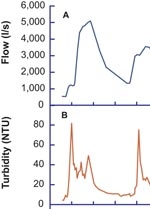
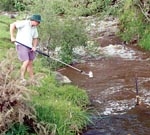
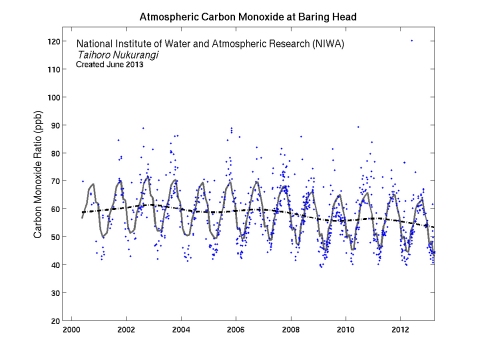
Rob Davies-Colley John Nagels Andrea Donnison Richard Muirhead
Floods can make farm streams very dirty indeed: they stir up not only the sediment on the bottom, but trillions of bacteria as well.
Pastoral agricultural streams in NZ are chronically contaminated by livestock faeces – washed in during rainstorms or else deposited directly when animals get into the channel. Most of this faecal contamination is usually found not in the stream water, but in the sediments. This means that when the muddy bottoms of farm streams are disturbed, the resulting turbid plumes can be heavily contaminated with faecal indicator bacteria, or “bugs” – up to a billion of them in every cubic metre.
Faecal contamination of an agricultural stream
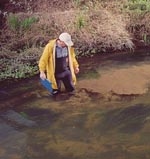
We reached these conclusions following a study of faecal contamination of a pastoral agricultural stream that drains a catchment in dairy and dry stock (sheep/beef) farming. In our study stream – the Topehaehae, near Morrinsville in the Waikato Region – during normal flows there are typically about 100 faecal indicator bacteria per 100 ml.
During a natural flood in September 1999 in the Topehaehae Stream we measured very much higher concentrations of bugs in the water, peaking at around 40,000 per 100 ml. In fact, the number of bacteria washed out over about three days by this one flood event was more than that washed out in a full year at normal flows; and the maximum number of bacteria passing per second was about the same as that typically flowing in the Waikato River, which is 100 times larger than the Topehaehae.
During this flood the bacteria concentrations correlated much more closely with turbidity than with flow, apparently because bacteria behave rather like fine sediment. (Turbidity is a convenient index of fine suspended matter in the water.)
The first set of graphs shows that both bacterial concentrations and turbidity peaked before the flood peak. The relationship between turbidity and bacterial concentrations is shown in the inset graph.
In a flood, the bacteria could have come from the stream sediments, or from faecal deposits on pasture washed into the stream. To study the sediment source of bacteria separately from pasture wash-in, we created short artificial floods in the stream by releasing water from a water reservoir (supplying Morrinsville) located on the upper reaches of the Topehaehae Stream. The experiments were carried out during fine weather when the stream channel was the only possible source of bacteria.
The second set of graphs shows the results of an experiment in which a series of three identical flood events were produced on three successive days. Just as with the natural flood, the bacteria peaked well ahead of the flow peaks, and there was a good correlation between faecal bacteria and turbidity caused by fine sediment entrained by the flood flows. This shows that much of the faecal contamination mobilised by floods comes from the sediments of the stream.
The faecal contamination produced by the first event peaked at 13,000 bacteria per 100 ml, and the bacteria peaks were lower on subsequent events due to progressive wash-out of the sediment store of bacteria. By assuming that an infinite number of identical floods would wash out every last bacterium in the stream, we calculated the size of the sediment store: 100 million bacteria per square metre of streambed.
From our measurements, we concluded that most of the time the water in this agricultural stream contains only a tiny fraction (about 1/1000) of the total faecal contamination in the stream. The rest is in the streambed, from where it can be released by floods, but also by livestock walking in the channel or, more ominously, by children wading in the stream.
The flushing out of bacteria by floods is not so much a problem in the stream itself as in waters well downstream, including lakes and estuaries. Faecal contamination by floodwaters from pastoral agricultural land is a threat to shellfish gathering and shellfish aquaculture in estuaries and coastal waters.
Sediment sampling for bugs
We are currently trying to devise ways to directly measure the faecal bacteria in stream sediments. In sandy areas of streambed, this is not too difficult, but sampling of rocky streambeds is not straightforward. We know that the bacteria are not present on the accessible rocks of the streambed surface, probably because sunlight, which is highly bactericidal, kills exposed cells. It is more likely that the bacteria lie deeper in the stream sediment, under the shade of surface rocks. We are also testing continuously measured turbidity as a surrogate for bacterial analysis in several ongoing studies of faecal pollution.
We expect this research will contribute to a better understanding of faecal pollution of streams by livestock in this country. Our findings will contribute to the development of systems for improving water quality and reducing downstream impacts, notably on shellfish aquaculture.
Indicator bacteria
Faecal indicator bacteria such as Escherichia coli are not themselves dangerous to humans (apart from some rare exceptions). These bacteria (and others such as faecal streptococci) are used to indicate faecal contamination – and therefore health risk – because they are always present in faeces of warm-blooded animals, including livestock, wild animals, and people. In contrast, the pathogens (disease-causing micro-organisms) are only present sporadically in faecally contaminated waters and are not suitable for routine monitoring.
The concentration of faecal indicator bacteria is expressed, traditionally, per 100 ml water. One reason for retaining this (non-standard) volume unit is that it approximates a small cupful – the amount of water a person may consume during swimming. More importantly, people who work in water quality and related fields are used to thinking in terms of bacteria concentrations per100 ml.
Human pathogens
In New Zealand, faecal contamination of waters by our approximately 10 million cattle and 45 million sheep, and increasing numbers of other livestock (notably 2.6 million deer), greatly outweighs the contribution of our 4 million people. But is animal faecal contamination really a problem?
People are often more concerned about contamination by human sewage than by animal faeces. However, animals can carry many diseases of humans (caused primarily by bacterial or protozoan pathogens). An example is campylobacteriosis – a very high-incidence disease in New Zealand (400 cases per 100,000 people per year). Recent research suggests that campylobacteriosis may be amplified by livestock faecal contamination of waters.
Guidelines for water quality are usually expressed in terms of concentrations of indicator bacteria like E. coli with the (reasonable) assumption that, where these bacteria are present, pathogenic organisms like Campylobacter and Cryptosporidiim could be too.
Further reading
Muirhead, R.W. (2001). Faecal contamination and flood events in a rural stream. Unpublished MSc thesis, University of Waikato, Hamilton.
Muirhead, R.W.; Davies-Colley, R.J.; Donnison, A.M; Nagels, J.W. (2004). Stream faecal contamination during artificial flood events: the importance of in-channel stores. Water Research 38: 1215–1224.
Nagels, J.W.; Davies-Colley, R.J.; Donnison, A.M; Muirhead, R.W. (2002). Faecal contamination over flood events in a pastoral agricultural stream in New Zealand. Water Science and Technology 45(12): 45–52.
Rob Davies-Colley and John Nagels are based at NIWA in Hamilton; Andrea Donnison is at AgResearch, Hamilton, and Richard Muirhead at AgResearch, Mosgiel.
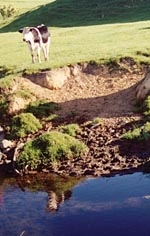
Teachers’ resource for NCEA AS: Biology 1.8, 2.9, 3.2; Science 2.2; Agricultural & Horticultural Science 1.5. See other curriculum connections at www.niwa.co.nz/pubs/wa/resources
